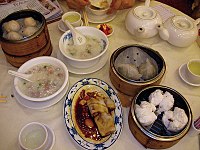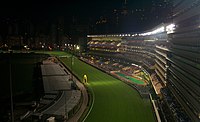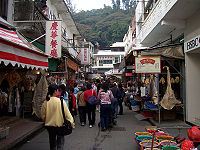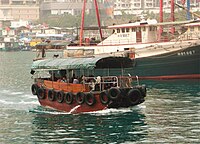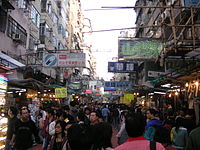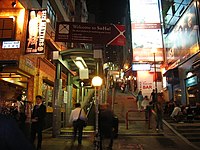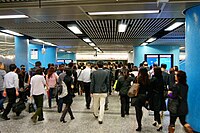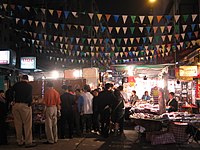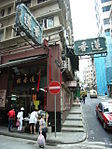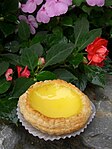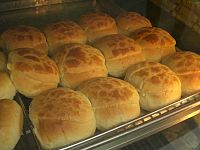Atracciones turísticas

Hong Kong es mucho más que una ciudad portuaria. El viajero cansado de sus calles llenas de gente puede verse tentado a describirla como "Hong Kongcreto". El centro posee muchas características en las que se fusiona la cultura china y la occidental, las costumbres antiguas y las modernas. Del estilo colonial a los templos antiguos, las viejas construcciones en los hechos se ven dispersos entre los rascacielos que dominan el horizonte. Esos edificios, junto con el mundialmente famoso Puerto Victoria, forman el paisaje único de la ciudad de Hong Kong.
Yet, this territory with its cloudy mountains and rocky islands is mostly a rural landscape. Much of the countryside, amounting to 40% of Hong Kong's land mass, is classified as Country Park. Although it is impossible to completely escape a population of 7 million, it is easy to find pockets of wilderness that will reward the more intrepid tourist, especially places having scenic countryside viewpoints offering a skyline panorama of downtown Hong Kong. For the trailwalker, there are the well-known MacLehose Trail and Wilson Trail. In addition, you are never far from the sea in Hong Kong and going to a good beach is always only a bus-ride away.
Chinese culture is something worth exploring in Hong Kong. From crowded street markets to rural indigenous villages in the New Territories, Cantonese gourmet, Cantonese opera and Buddhism, Taoism, and Confucianism all in the same temple, Hong Kong features the best preserved Chinese and Cantonese culture in the region, a result of the lack of political turbulence in the city's history.

Attractions
The venue is adjacent to Tsim Sha Tsui (尖沙咀), where is the most popular hang out of the locals, with many shopping malls, gourmet, bars, cafés and cultural experiences. In Jordan (佐敦)—a nearby neighborhood just north to Tsim Shui Tsui you can find a lot of rather local gourmet fares.

- Tsim Sha Tsui is a major shopping area for locals and visitors with a number of major Shopping Malls in the area. You can find most of the world-famous luxury brands in these malls, although they are mostly frequented by tourists from the Mainland China.
- Kowloon Waterfront offers splendid views of the Hong Kong island shore and skyline. This is the best place to experience the classic view of Hong Kong, and nobody on their first trip here should miss out on promenading along the waterfront. The best views are to be had at night when the lights of the global capitalism provide a powerful spectacle. Every night at 8 pm there is a colourful light show, called "A Symphony Of Lights", that is staged atop the key buildings on both sides of the harbour.
- Nathan Rd is the main artery of Kowloon peninsula showing you a typical Hong Kong urban landscape, a chaotic mix of skyscrapers and Cantonese style old buildings of merchandising stores and residential buildings, where you can even see an Anglican Church within the mix. Once referred "Golden mile" of Hong Kong, streets lined with a chaotic array of neon signs hanging from the building are world famous. It is also a major shopping strip for both locals and visitors, with all kinds of small stores and huge department store for everyday needs.
- Take a walk in Kowloon Park where you will find not only pleasant gardens but aviaries, museums, and sporting facilities including Hong Kong's best swimming pool complex, which offers both indoor and outdoor pools. The main pool with lane swimming in the lush-green setting is complemented by a wide-range of swimming, diving and children's play-pools appealing to adults and children alike.
- Temple Street south of Mong Kok is a great place to eat Chinese street food. Temple Street, famously featured in Chinese cinema, is one of the few pedestrianised streets in Kowloon where you can sit, relax and watch as the world is passing by. Seafood is a popular choice, but most restaurants will provide you with an extensive English/Chinese menu that caters for most tastes. Frog is a tasty option, or try the oyster omelettes.

If you would like to go further, you can either take East Rail Line to Mong Kok East from Hung Hum Station, or take buses to different hang-outs on the Hong Kong Island, from the Cross Harbour Tunnel Bus Terminus. Both the train station and the bus terminus are next to our venue, PolyU.
- Mong Kok (旺角) has a huge choice of shops and markets in an area of less than a square kilometre. You can also find many Cafés, and every kind of food from local street food to high end Western dishes. It is a rather local hangout, where you can find clothes, sports shoes, electronic gadget and karaoke. Visitors may find Tong Choi St & Fa Yuen St interesting, as they are few remaining street markets in the territories.
- Wan Chai (灣仔) is much more than a couple of blocks of girlie-bars populated by drunken American sailors; after all, the World of Suzie Wong was just a work of fiction set in Wan Chai during a bygone age. Located between Causeway Bay and Admiralty, Wanchai has an inner-city feel that makes it an interesting but safe area to walk around at any time. Wan Chai has traditional street markets that, unlike many other neighbourhoods, are still outdoors. In the so-called wet-markets, butchers hang animal carcasses on large hooks that overshadow pavements and fishmongers have stalls with live fish that do their best to escape. Between Johnston Road and Queen's Road East are numerous alleys that are worth exploring if you are looking for traditional family-run shops selling anything from tropical fish to cheap clothing.

- Central (中環), previously known as Victoria, this is 'downtown' Hong Kong and maybe defined as the area within walking distance of Central MTR station. Head north towards the harbour and you will find modern buildings such as the IFC shopping mall. Alternatively, make your way uphill towards the mountain and you will encounter some of the oldest parts of Hong Kong.
- Victoria Peak (山頂) a high class neighbourhood and popular tourist destination that looks down on Central and Victoria Harbour.
- Causeway Bay (銅鑼灣), shopping district that is home to large department stores, such as Sogo. Causeway Bay is one of the most densely populated areas of Hong Kong, crowded most of the time, but here you can eat and shop until very late. Some major supermarkets and eateries stay open 24 hours. Times Square in Causeway Bay is a major focal point, especially at the 'calendar' New Year when you will be wise to stay away if you hate crowds. The area is also popular among Hong Kong's youth and is a good place to observe the latest fashion trends.
- Yuen Long (元朗) in Northwest New Territories is an area worth to explore, where you can find Hong Kong's oldest buildings in Yuen Long Kau Hui. You may also explore Ping Shan Heritage Trail (屏山文物徑), in nearby Tin Shui Wai. This is a kilometre long trail enabling you to take in the most important buildings in this indigenous village, including the ancient pagoda of Tsui Shing Lau, the Tang Ancestral Hall and the Kun Ting Study Hall.
Hong Kong's islands have been and to some extent continue to be Hong Kong's hinterland, home to rustic fishing villages battered by the occasional typhoon, monasteries run by hardscrabble monks and little else. However, the last decade or so have seen some changes.
- Cheung Chau (長洲) still has a traditional community based on an active fishing fleet and many thriving seafood restaurants. It has a number of reasonable hiking trails and some usable beaches. If you only have time to visit one island, then you might consider Cheung Chau.
- Peng Chau (坪州) has a reputation for being dull and lacking in tourist attractions. Yet, if you go there expecting to see very little, you may be pleasantly surprised. Good seafood restaurants here are cheaper than on other islands and you get the feeling that you are off the 'beaten-track' of mass tourism. Perhaps it is the place to go at the end of your holiday when you are weary of the fast-pace of the big city and just want to slow down, have a drink and chat with friends. From Peng Chau you can easily take the dilapidated ferry over to the Trappist monastery on Lantau island and walk, for a couple of hours, along the hilly footpath to Mui Wo (梅窩). From Mui Wo you can take another ferry back to Hong Kong island. It is located 8 km to the west of Hong Kong Island. The size of the island is 1 km square. Peng Chau, as the name suggests, is mostly flat land.
- Lamma Island (南丫島) has become increasingly popular with Western hippies who have created their own small residential community in Yung Shue Wan (榕樹灣). On both sides of the island you will find attractive bars, restaurants and cafes, making it a popular destination for local Chinese people out on a day trip.
Museum and cultural facilities
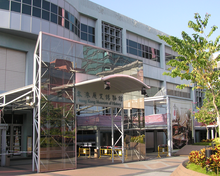
The proposed conference venue is next to East Tsim Sha Tsui, Hong Kong's museum district with four major museums and other cultural venues along the promenade. We hope that this geographical proximity may boost our efforts in WP:GLAM outreach! A one-week museum pass for all exhibitions in these museums are available for HK$30 (US$4, €3, £3).* Hong Kong Science Museum. Large museum with many interactive exhibits including a energy machine and an airplane. A museum which decided to make an architectural statement about its purpose, yet somehow got it horribly wrong. Although primarily aimed at children, museum-savvy adults will also certainly find an amazing time playing with the exhibits, and the maths puzzles and optical illusions are challenging to adults and children alike. The museum hosts the world's biggest energy machine which spans the entire museum and runs for a few minutes every two hours.
- Hong Kong Museum of History. A history museum in its conventional sense, but better. Experience the Hong Kong Story and forget the idea that all of Hong Kong museums are frumpy and boring. The Hong Kong Story is a real must go and do, ideal for those who want to make sense of Hong Kong's vibrant past in a way that is engaging and interactive. Allow at least two hours for your visit. Special exhibitions are also available, usually covering a specific era in the history of Hong Kong.
- Hong Kong Museum of Art. The national gallery of Hong Kong, the Museum of Art hosts permanent and temporal exhibitions of paintings, calligraphy, pottery and other artistic artifacts from both local artists, China, and the West.
- Hong Kong Space Museum. Affectionately known as "the egg" by locals, the museum has the oldest planetarium cinema (hence "the egg") in Hong Kong, long before the days of IMAX. It also houses a permanent exhibition on astronomy.
- Hong Kong Cultural Centre. The Cultural Centre is the prime theatre and concert location in Hong Kong, and is the home concert hall of the Hong Kong Philharmonic Orchestra. Despite its peculiar exterior shape, the architecture has created a superb indoor space that is ideal for the sights and sounds of each performance. Its comfortable atmosphere and clean, free lavatories made it a hotspot for locals and tourists alike.

Location of above places can be found on this google map.
Gallery
-
The Peak Tower
-
Dim Sum
-
Happy Valley Racecourse at night
-
Tai O Market
-
Repulse Bay
-
A sightseeing Sampan of Aberdeen
-
Cantonese Opera
-
Jumbo Kingdom at night
-
The market in Apliu Street
-
Wong Tai Sin Temple
-
Cross Harbour Tunnel
-
Chi Lin Nunnery
-
Symphony of Lights
-
Big Buddha
-
SoHo, a lively dining district
-
Hong Kong Wetland Park
-
Lan Kwai Fong
-
Graffiti of Tsang Tsou Choi aka Emperor of Kowloon
-
Bank of China Tower
-
Mong Kok
-
Statue Square abuts Connaught Road
-
Nathan Road, Jordan section
-
People rush to another line in MTR Admiralty Station
-
Siu Mei/ Cantonese Barbecued food
-
The Peak Tram of Hong Kong
-
Buses at the Tsim Sha Tsui Ferry Pier Terminus
-
Seafood Cuisine store
-
Temple Street
-
Teahouse
-
Tram
-
Egg Tart
-
Star Ferry
-
Pineapple Bun
-
Ngong Ping 360
-
Rice Roll


